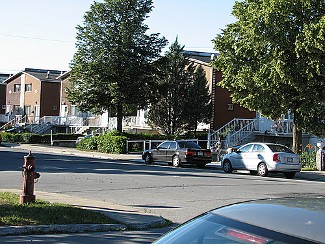

Montreal DistrictsRiviere-des-PrairiesRiviere-des-Prairies, one of the two most recent districts of Montreal, did not get its name from the local geography. The territory has been named after the sieur des Prairies, a contemporary of Samuel de Champlain. They both navigated on the river in 1615.
Up until recently, the distant territory was nothing more than a large agricultural village. Every spring the arrival of the "draveurs", of guys like the well known Jos Montferrant was a familiar sight to the villagers. Some of the summer houses owned by Montrealers who wished to escape the asphalt and the heat still embellish the countryside. Today, in response to the extinction crisis, the nearby Rochon, Boutin, Lapierre and Gagné islands are all protected. Four major elements characterize the borough: the important residential sectors in each of the two districts, the industrial park in its central part and the large regional parks, the largest being the parc nature de la Pointe-aux-Prairies. Definition of Population
After the Second World War, the area experienced its first demographic expansion. But, the real demographic explosion, one that markedly transformed the territory, happened 25 or so years ago. As it was then and as it is now, the vicinity is appealing, especially to young families. The river is bordered with beautiful trees, the green areas are inviting, the neighbourhood is quiet and the various dwellings are quite affordable. Demographically, the population of Riviere-des-Prairies is generally young, perhaps the youngest in Montreal. One third of the residents are of Italian origin, half are francophones and the Haitian community is growing in number. Unfortunately, the sporting, cultural, and communal installations are still insufficient in number, while the existing ones are difficult to access. This is not the case with the Collège Saint-Jean Vianney however. The high school is located in the heart of the parc régional de la Pointe-aux-Prairies, near the river, and is easily accessible by car and by public and private transport. Jobs in my Area
In terms of jobs, the majority of the residents earn their living outside Riviere-des-Prairies. The territory harbours some industries, predominantly SMEs, and most of them are located on Henri-Bourassa. The industries newly installed on the territory are small. As a result, a certain hidden poverty is found in the basements of some of the dwellings. For the most part, the commercial activites are not concentrated in any given sector. The various retail stores are poorly distributed and too often far from the residential centres. Certain industrial zones overrun residential areas, thus creating a direct and unpleasant connection between industries and dwellings. Main Street CanvasRiviere-des-Prairies is sort of confined within its streets, its boulevards and its highways. Not having a car doesn't help the day to day life, nor does it help any industrial and residential development. The roads have been considerably improved, which is fine, but the public transport remains scarce. Transportation in the two districts is based on east-west major trunk roads. Notre-Dame and Sherbrooke Streets as well as Gouin, Perras, Maurice-Duplessis and Henri-Bourassa Boulevards, link the territory to any of the Montreal Districts including Ville-Marie and Downtown Montreal. The north-south major trunk roads are few. The CN railroad, the Metropolitan and de la Rive Nord Highway are authentic physical barriers that, very annoyingly, block the traffic to and from the rest of the Island. Thank you for visiting Riviere-des-Prairies. Pointe-aux-Trembles Exit Riviere-des-Prairies
|


























































